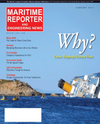
Page 43: of Maritime Reporter Magazine (February 2012)
Cruise Shipping Annual
Read this page in Pdf, Flash or Html5 edition of February 2012 Maritime Reporter Magazine
February 2012www.marinelink.com 43pany has devised a two-step process, the first of which is happening right now. Companies large and small are assisting the commercialization process either byindustry sector or world region, whereby they will help with assembly, distribu- tion and maintenance. This is targeted to the technology?s ?early adopters? of the technology (ie. those with difficult or non-existent options), including marine, hotels and resorts, military and security, hospitals, isolated communities andwork camps. Part two of the commer- cialization process will be the globalcommercialization effort, whereby the company will seek large corporate part- ner(s) that are positioned for global man-ufacturing, delivery and service. CHALLENGES AHEADWhile adoption of new technology can be painfully slow, particularly in markets such as maritime where a conservative gene seemingly pervades nearly every vessel owner, Tsantrizos reasons that he doesn?t see this as much of a challenge for one reason:?(Arguments for the technology) are actually presented by the shipowners themselves. They themselves know what they don?t want to have,? he said. Regardless, Tsantrizos still sees a few challenges ahead: Bringing down the cost and raising the system?s ease of use. ?My final vision is always focused on low cost and simple operation,? Tsantri- zos said. ?The issue here is the technol-ogy is still relatively expensive, and we need to find ways to reduce the cost.? Cost reductions will come in partthrough a rationalized manufacturing strategy. Today the company manufac- tures exclusively in Canada, but as it rolls out operations globally it will beable to take advantage of much lower manufacturing costs. The ability to pro- duce more machines, too, will help todrive costs down. In addition, he said the waste handling system must deliver commercially with an interface which allows anyone to op- erate it efficiently and safely. While the current (V5) version features a high-tech electronic interface with a series of but- tons and lights, Tsantrizos envisions a simplified control system, something akin to a washing machine, which will have the tandem benefit of reducing costs, too.Through all of the technical talk, gov- ernment partnerships and business chal- lenges, Tsantrizos eye remains on sustainability. ?We started ? and main- tain our course ? with a singular visionand mission; enabling people to take care of their own waste.? ?In the simplest way of putting it, we want to?cook? the waste using the fumes that are produced as the fuel. If you use the energy that is in the waste to cook the waste, you have Auto Gasification. The main objective is not toburn the waste, but to fracture the waste back to carbon and water. By sequestering the carbon, this also goes a long way in minimizing the greenhouse gases.? Dr. Panayotis (Peter) Tsantrizos, President, CEO and founder of Terragon Environmental Technologies Inc. (Image Courtey Terragon Environmental Technologies) Pictured, from Top Down TOPDr. Panayotis (Peter) Tsantrizos, President, CEO and founder of Terragon Environmental Technologies Inc., in his Montreal-based facility. CENTERThe Auto Gasification process, which essentially uses the energy from the waste to ?cook? the waste.BOTTOMThe latest iteration of the MAGS technology ? V5 ? undergoing final testing before its deployment into the field with Saudi Aramco.(Photo: Greg Trauthwein) (Photo: Greg Trauthwein) MR Feb.12 # 5 (42-48):MR Template 2/7/2012 10:05 AM Page 43

 42
42

 44
44
